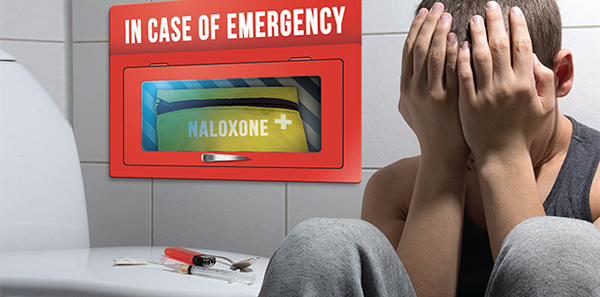
In-person education by staff or a drug counselor is interactive and can be combined with a referral to treatment. If in-person education is not feasible, video and handout materials are cheaper, portable, and uniform and can be referenced at home. However, they are less personal and less engaging and may miss an opportunity for referral to treatment. PrescribeToPrevent.org has educational materials tailored to different patient populations.17
Explore This Issue
ACEP Now: Vol 35 – No 03 – March 2016Back to the Case
Before the patient is discharged, he and his family are counseled on the dangers of heroin use, how to recognize an overdose, and the proper technique for administering naloxone. They are given some written educational materials and a naloxone kit to use if the patient overdoses again.
Conclusion
Emergency physicians treat patients with addiction and opioid overdose every day. Increasing access to naloxone is one strategy ED providers can use to reduce deaths due to opioid overdose. For more information about how to set up a program and to access the full ACEP TIPS webinar report, go to www.acep.org/traumasection.
Dr. Samuels is in the department of emergency medicine at Alpert Medical School of Brown University in Providence, Rhode Island. Dr. Hoppe is in the department of emergency medicine at the University of Colorado School of Medicine in Denver. Dr. Papp is in the department of emergency medicine at Case Western Reserve University School of Medicine in Cleveland, Ohio. Dr. Whiteside is in the department of emergency medicine at the University of Washington in Seattle. Dr. Raja is in the department of emergency medicine at Boston Medical Center, Boston University School of Medicine. Dr. Bernstein is in the department of emergency medicine at Massachusetts General Hospital, Harvard Medical School in Boston.
References
- Rockett IR, Putnam SL, Jia H, et al. Unmet substance abuse treatment need, health services utilization, and cost: a population-based emergency department study. Ann Emerg Med. 2005;45(2):118-127.
- Substance Abuse and Mental Health Services Administration, Drug Abuse Warning Network, 2011: National estimates of drug-related emergency department visits. HHS Publication No. (SMA) 13-4760, DAWN Series D-39. Rockville, MD: Substance Abuse and Mental Health Services Administration, 2013.
- Walley AY, Xuan Z, Hackman HH, et al. Opioid overdose rates and implementation of overdose education and nasal naloxone distribution in Massachusetts: Interrupted time series analysis. BMJ. 2013;346:f174.
- Dwyer K, Walley AY, Langlois BK, et al. Opioid education and nasal naloxone rescue kits in the emergency department. West J Emerg Med. 2015;16(3):381-384.
- Samuels E. Emergency department naloxone distribution: a Rhode Island department of health, recovery community, and emergency department partnership to reduce opioid overdose deaths. R I Med J. 2014;97(10):38-39.
- Coffin PO, Sullivan SD. Cost-effectiveness of distributing naloxone to heroin users for lay overdose reversal. Ann Intern Med. 2013; 158(1):1-9.
- Inocencio TJ, Carroll T, et al. The economic burden of opioid-related poisoning in the United States. Pain Med. 2013;14(10):1534-1547.
- Naloxone overdose prevention laws map. Public Health Law Research Web site. Accessed Oct. 15, 2015.
- Legal interventions to reduce overdose mortality: naloxone access and overdose Good Samaritan laws. The Network for Public Health Law Web site. Accessed Oct. 23, 2015.
- Naloxone for community opioid overdose reversal. Public Health Law Research Web site. Accessed Oct. 23, 2015.
- Opioid overdose prevention programs providing naloxone to laypersons — United States, 2014. Morbidity and Mortality Weekly Report. Centers for Disease Control and Prevention Web site. Accessed Sept. 30, 2015.
- Kerr D, Kelly AM, Dietze P, et al. Randomized controlled trial comparing the effectiveness and safety of intranasal and intramuscular naloxone for the treatment of suspected heroin overdose. Addiction. 2009;104(12):2067-2074.
- Barton ED, Colwell CB, Wolfe T, et al. Efficacy of intranasal naloxone as a needleless alternative for treatment of opioid overdose in the prehospital setting. J Emerg Med. 2005;29(3):265-271.
- Evzio (naloxone hcl injection) 0.4 mg auto-injector. Evzio Web site. Accessed Sept. 30, 2015.
- Formulations. Prescribe to Prevent Web site. Accessed Sept. 30, 2015.
- Kaléo Cares Patient Assistance Program. Evzio Web site. Accessed Oct. 22, 2015.
- Materials. Prescribe to Prevent Web site. Accessed Sept. 30, 2015.
Pages: 1 2 3 4 | Single Page





One Response to “Naloxone Distribution Strategies Needed in Emergency Departments”
April 3, 2016
Larry A. Bedard, MD FACEPACEP has come a long way since 2010 when a wacko doctor from California-me- introduced resolutions to have naloxone over the counter and recommend EPs prescribe naloxone in the ER.
However, ACEP still has a long way to go. Tp deny our role in the opiod epidemic, while frequently blaming other specialities for the epidemic is the wrong approach.